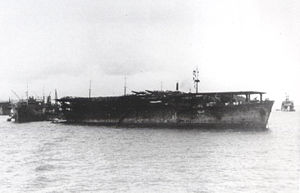- Japanese aircraft carrier Chūyō
-

ChūyōCareer (Japan) 
Name: Chūyō Laid down: 9 May 1938 Launched: 20 May 1939 Commissioned: 25 November 1942 Fate: Sunk by the submarine USS Sailfish, 4 December 1943 General characteristics Class and type: Taiyō-class escort carrier Displacement: 17,830 long tons (18,120 t) (standard)
19,500 long tons (19,800 t) (full load)Length: 173.7 m (569 ft 11 in) (w/l)
180.4 m (591 ft 10 in) (o/a)Beam: 22.5 m (73 ft 10 in) Draft: 7.74 m (25 ft 5 in) Installed power: 25,200 shp (18,800 kW) Propulsion: 2 × Kampon geared steam turbines
4 × Kampon water-tube boilers
2 × shaftsSpeed: 21 kn (39 km/h; 24 mph) Range: 6,500 nmi (12,000 km; 7,500 mi) at 18 kn (33 km/h; 21 mph) Complement: 850 Armament: Upon completion as escort carrier: 8 × 127 mm (5 in) L/40 Type 89 anti-aircraft guns (4x2)
30 × 25 mm (0.98 in) L/60 Type 96 anti-aircraft cannonsArmor: 2.5 cm (0.98 in) side belt over machinery spaces and magazines Aircraft carried: 27 Chūyō was a Taiyō-class escort carrier operated by the Imperial Japanese Navy in World War II.
Contents
Construction and Conversion
The SS Nitta Maru (新田丸) was an ocean liner of the Nippon Yusen shipping line, laid down in the Mitsubishi shipyard in Nagasaki in May 1938, launched in May 1939 and commissioned on 23 March 1940. Requisitioned for use as a military transport in February 1941, she made a few voyages, including a number for transferring of American Prisoners of War (POWs) from Wake Island to Japan.
The first transfer of POWs departed Wake Island on 12 January 1942, arriving in Yokohama on or around 20 January. After departing Yokohama, the Japanese took five men topside, and to "honor their bravery," tortured and beheaded them. The bodies were mutilated with bayonets and thrown overboard.[1]
After the Battle of Midway, it was decided to convert her to an escort carrier. The conversion took place in Kure between 20 August and 25 November 1942. She was renamed Chūyō (冲鷹, "Hawk which soars").
Her flight deck measured 150 × 23 m (490 × 75 ft) and was equipped with two elevators. She had no island, catapults or arresting gear.
Operational history
Chūyō was used primarily for flight training and aircraft transport. She often sailed with her sister ships Taiyō and Unyō.
On 4 December 1943, Chūyō and Unyō were sailing from Truk to Yokosuka—carrying prisoners the Japanese took from the American submarine USS Sculpin—when Chūyō was hit by a torpedo fired by USS Sailfish at 32°37′N 143°39′E / 32.617°N 143.65°E, close to the island of Hachijōjima. During the next few hours, Sailfish attacked the damaged carrier two more times. After taking four of the five torpedoes the submarine had fired at her, Chūyō sank quickly, taking about 1250 people with her; 20 of the 21 prisoners she was carrying were among them. She was stricken from the naval list in 1944.
See also
- List by death toll of ships sunk by submarines
Notes
- ^ Wake Island POWs at Zentsuji (Accessed 09-June-2007)
References
- Dr. Bak József et al. (1984): Hadihajók. Típuskönyv. Zrínyi Katonai Kiadó. ISBN 963-326-326-3
External links
- Imperial Japanese Navy Page
- Carriers of World War Two
- Taiyo Class
- Naval Weapons of the World
- Warship.get.pl
- Japanese "Maru" Ships
- IJN Chuyo: Tabular Record of Movement
List of ships of the Japanese Navy Categories:- Taiyō class escort carriers
- Ships built in Japan
- 1939 ships
- World War II escort carriers of Japan
- Ships sunk by American submarines
- World War II shipwrecks in the Philippine Sea
Wikimedia Foundation. 2010.
